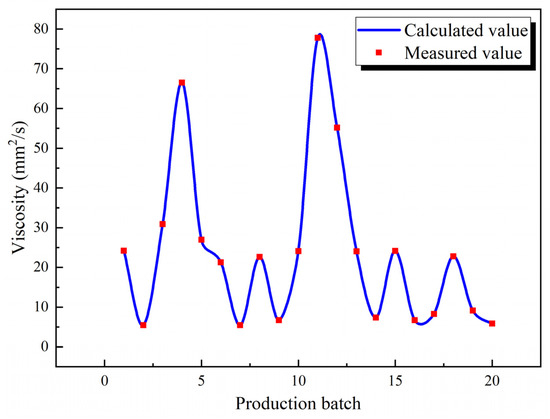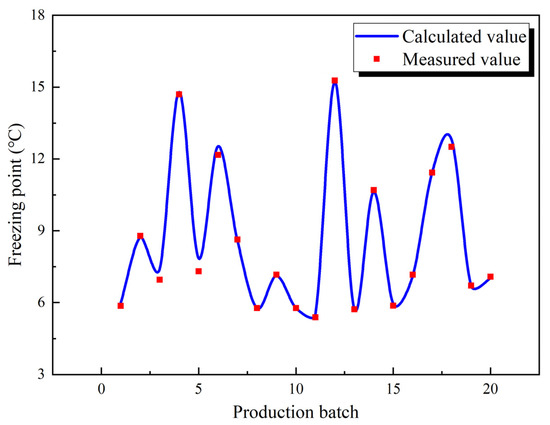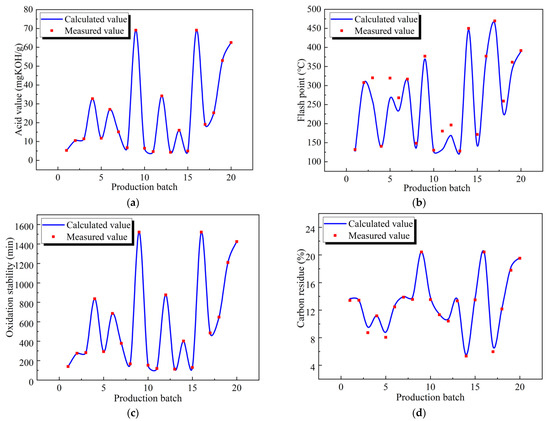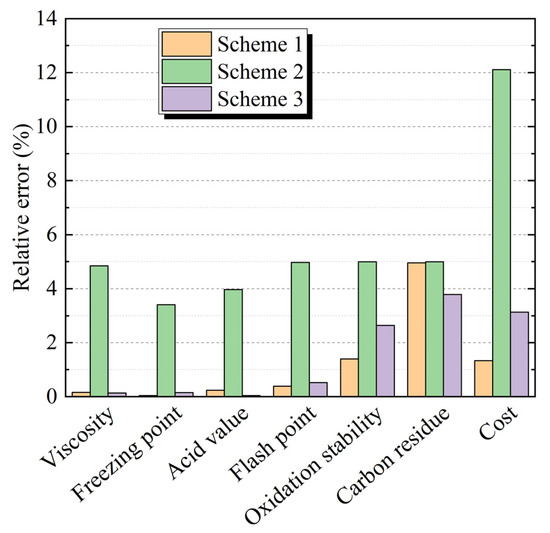Featured Application
The results obtained in the study can be applied to the optimization of the blending scheme of industrial lubricating oil.
Abstract
Based on actual lubricating oil production data and the base oil performance indexes of an enterprise, two nonlinear blending schemes corresponding to viscosity and freezing point and four linear blending schemes corresponding to acid value, flash point, oxidation stability, and carbon residue are given in this paper. On the premise that the error of each index is less than 5%, a linear weighted multi-objective optimization model based on integer nonlinear programming considering cost and performance is established, and the lubricating oil blending scheme is obtained. The results show that the blending formula is simple in form and convenient in calculation, and that the overall consistency between the calculated value and the measured value is good. At the same time, the relative error of each performance index, except residual carbon, of the scheme with weight value of (0.5, 0.5) is far less than 5%. Although the performance index is slightly inferior to that of the scheme with a weight value of (0, 1), it is far higher than that of the scheme with a weight value of (1, 0). The linear weighted multi-objective optimization model based on integer nonlinear programming proposed in this paper can well-optimize the blending scheme of industrial lubricating oil, and can re-select different weight combinations according to the actual situation, providing good prospects for application.
1. Introduction
Industrial lubricating oil is a liquid or semi-solid lubricant used in various types of automobiles and mechanical equipment to reduce friction and protect machinery and machined parts. It mainly plays the roles of lubrication, auxiliary cooling, rust prevention, cleaning, sealing, and cushioning [1,2]. At present, the demand for lubricating oil shows a trend of specialization and customization. Different mechanical equipment and applications have different requirements for lubricating oil performance, so there is an urgent need for enterprises to produce specific-quality lubricating oil according to the actual demand.
Lubricating oil products are prepared by mixing two or more base oils with different properties [3,4] according to a certain proportion. However, the varieties of base oils refined by oil refining enterprises are limited, so it is necessary to use limited base oils to prepare the required lubricating oils. Therefore, the blending of base oils is the basis for the preparation of lubricating oil products. The most common method of lubricating oil blending is tank blending, as shown in Figure 1.

Figure 1.
Production process of lubricating oil tank blending.
The physical and chemical properties of oil products change when they are blended. The linear or nonlinear relationship between this change and the properties of each blending component is expressed as an additive effect between the components. A certain physical and chemical property equal to the superposition of each component according to its composition ratio is called linear harmony; otherwise, it is called nonlinear harmony. The chemical composition of oil products and additives [5] is very complex, and their physical and chemical properties generally do not have an additive effect, so the blending of lubricating oil is mostly nonlinear. In addition, the performance indexes of lubricating oil mainly include viscosity [6,7,8], freezing point [9], acid value [10], flash point [11], oxidation stability [12,13], residual carbon [14], and so on. Therefore, the optimization of the design of a lubricating oil blending scheme [15] mainly includes two aspects: one is to select the base oils reasonably to meet the performance index requirements of the blended product; the other is to establish the blending mathematical model [16] and determine the blending scheme of each base oil on the premise of meeting the product performance indexes.
The blending formula of early lubricating oil was mainly optimized by the linear programming method. However, many important technical indexes of lubricating oil do not show a simple linear relationship with the content of each component. If the oil products are blended according to the linear programming method, the prediction accuracy of the performance of the blended product will be poor, and unable to meet the actual needs of production. In recent years, many experts and scholars in the field of lubricating oil have studied the nonlinear [17,18] relationship between important indexes of lubricating oil and the content of each component, and have obtained many accurate prediction models.
The blending of lubricating oil is a relatively complicated process. This paper ignores the production technology and process of lubricating oil, and does not consider the issue of additives. A certain index of lubricating oil is only related to the corresponding index of the base oil. In this paper, a multi-objective optimization model of lubricating oil based on integer nonlinear programming is established to optimize the design of the blending scheme so that it meets various performance indexes and, at the same time, is lower in cost.
2. Data Processing and Blending Scheme
2.1. Data Processing
Table 1 shows the base oil performance index parameters and prices of an enterprise, Table 2 shows the production data of each batch of blended oil, and Table 3 shows the performance index of each batch of blended oil. The specific data follow.

Table 1.
Performance indexes and costs of base oils.

Table 2.
Production data of each batch of blended oil (unit: ton).

Table 3.
Performance indexes of each batch of blended oil.
Firstly, the data of each batch and oil production of the enterprise are normalized to calculate the mass fraction of base oil in each batch of blended oil. The calculation formula is as follows:
where represents the mass fraction matrix of blended oil, represents the mass fraction of base oil in batch of blended oil, and represents the total mass of batch of blended oil.
2.2. Blending Scheme
In this paper, the viscosity of each oil batch is calculated using the internationally common viscosity blending calculation formula [19]. For the other indexes—freezing point, acid value, flash point, oxidation stability, and carbon residue—the linear blending formula is applied to predict the lubricating oil indexes. The indexes with low prediction accuracy are adjusted nonlinearly, and, finally, the blending scheme of a complex power polynomial is established for high-precision prediction. The calculated values of these models are compared with the measured values.
Viscosity is one of the most important characteristics of lubricating oil and a performance index that should be considered first in lubricating oil blending. In addition, the viscosity of lubricating oil is an important basis for classifying oil brand numbers. The viscosity calculation formula is established as follows:
where represents the calculated value of the viscosity of batch blended oil, represents the actual value of the viscosity of base oil , and represents the type of base oil.
The relationship between the calculated viscosity value and the measured value of each batch of blended oil calculated according to the formula is shown in Figure 2. The calculated value is in good agreement with the measured value, and the error is 0.002%. Therefore, the calculation formula can be used directly.

Figure 2.
Comparison between the calculated value and measured value of viscosity.
As the interaction between the components of crude oil becomes more complex after mixing, and there are many influencing factors, there is currently no theoretical method to calculate the freezing point of mixed crude oil. Most of the existing calculation models are empirical or semi-empirical formulas derived by scholars based on experimental data [20]. It can be seen in Table 1 and Table 3 that there is a big difference between the freezing point of base oil and that of blended oil, and it does not meet the linear relationship. So, the nonlinear relationship is considered. It is assumed that the freezing point of blended oil and the freezing point of base oil meet the following relationship:
where represents the calculated value of the freezing point of batch blended oil, represents the actual value of the freezing point of base oil , and represents the type of base oil.
Adjustments are made to and to make the error between the calculated value of the freezing point and the measured value as small as possible, that is, to make the value of as small as possible. This satisfies the following relationship:
where is the calculated value of the freezing point of batch blended oil, and is the required value of the freezing point of batch blended oil.
Using a nonlinear least-squares algorithm, the values of and are 0.4754 and −0.003, respectively. A comparison between the calculated value and the measured value obtained by this formula is shown in Figure 3. The calculated value is in good agreement with the measured value, and the average error is 1.546%, so the calculation formula can be used directly.

Figure 3.
Comparison between calculated value and measured value of freezing point.
The acid value of lubricating oil is an important index of organic acid substances in the oil, and its change reflects the degree of oxidation and corrosion of the oil, to a certain extent. The flash point of lubricating oil is an index of the ignition risk of the oil product. The oxidation stability of lubricating oil is an important characteristic that reflects the oxidation deterioration or aging tendency of the oil in the process of its actual use, storage, and transportation. The carbon residue value can indirectly indicate the degree of refining of the base oil. Generally, the carbon deposition tendency of a lubricating oil in the process of its use is predicted according to its carbon residue value. Finally, the acid value, flash point, oxidation stability, and carbon residue of the above oil products are fitted by a linear relationship, which is as follows:
where represents the mass fraction matrix of the blended oil, represents the actual value of the index of the base oil , and represents the calculated value of the index of the batch of blended oil.
Comparisons between the calculated values and the measured values of these four indexes of oil—acid value, flash point, oxidation stability, and carbon residue—using linear relations are shown in Figure 4. The errors are 0.002%, 2.558%, 0.00006%, and 2.766%, respectively. The errors are small and meet the design requirements.

Figure 4.
Comparisons between calculated and measured values. (a) Acid value; (b) flash point; (c) oxidation stability; (d) carbon residue.
Compared with references [6,7,8,9,10,11,12,13,14], the blending formula of the six performance indexes proposed in this paper are simple in form and convenient in calculation, and the calculated values are in good agreement with the measured values, which can well predict the related indexes of the blended oil.
3. Establishment and Solution of the Model
3.1. Determination of Objective Function
In the actual production of lubricating oil of specific quality, it is often necessary to consider both cost factors and performance factors [21]. Based on these, this paper establishes, firstly, the following objective function:
where and represent the weight of target and in the total objective function, respectively; represents the type of base oil; represents the maximum type of base oil; represents the quality of base oil in the blending oil formulation scheme; represents the price of base oil ; represents the type of blending oil index; represents the maximum type of blending oil index; and the represents the relative error of each index.
3.2. Determination of Constraint Conditions
Constraint conditions were established by the following:
where represents the total quality of base oil in the blended oil formulation scheme, represents the divisor of each base oil quality adjustment, represents the control relative error of each index, represents the required value of index of batch blended oil, represents the calculated value of index of batch blended oil, and represents the unit cost of the base oil.
3.3. Solution and Analysis of Nonlinear Programming Model
A customer requested 80,000 tons of lubricating oil at a cost of no more than CNY 3500.00 per ton, and with performance indexes as shown in Table 4 (the error of each index is no more than 5%). It can be seen that the maximum type value of the base oil in the objective function corresponds to 10, and the maximum type value of the blending oil index corresponds to 6. In the corresponding constraint conditions, the total mass of the base oil in the blending oil scheme is 8000. To ensure that the quality of base oil is adjusted to an integer multiple each time, the value of is 100. The relative error of each index is 5%, the maximum value of batch of the blended oil corresponds to 20, the unit cost of the base oil is CNY 3500.00, and the other values correspond to the data in Table 1, Table 2 and Table 3.

Table 4.
Product index requirements.
This paper presents three blending schemes in which the weights of cost and performance are (1,0), (0,1), and (0.5,0.5). For nonlinear programming models, the primary underlying technique used by LINGO’s optional nonlinear solver is based upon a generalized reduced gradient (GRG) algorithm [22]. Based on the GRG algorithm, this paper determines the optimal solution. The computation time of the three blending schemes is 0.5 s, 1.0 s, and 2.0 s. The blending schemes are shown in Table 5. The calculated values and required values of each index and the cost of each blending scheme are compared in Table 6. The comparison of the relative error between the calculated value and the required value of each index and the cost of each blending scheme is shown in Figure 5.

Table 5.
Comparison of the three blending schemes of 80,000 tons (unit: ton).

Table 6.
Comparison of the calculated and required values of product performance indexes under the three blending schemes.

Figure 5.
Comparison of the relative error between the calculated value and required value of the index and the cost.
According to Table 6 and Figure 5, all performance indexes of Scheme 1 meet the requirement that the relative error does not exceed 5%. At the same time, the cost is CNY 3453.25 per ton, which is lower than the CNY 3500.00 per ton required by the customer.
All performance indexes of Scheme 2 meet the requirement that the relative error does not exceed 5%. The cost is CNY 3075.96 per ton, which is lower than the CNY 3500.00 per ton required by the customer and far lower than the CNY 3453.25 per ton of Scheme 1. However, the relative errors of all performance indexes except Index 2 are close to 5%, which is unfavorable to the overall performance of the blended oil.
The weights and in the objective function are determined according to the order of magnitude consistency principle of the two objective functions. According to Table 6 and Figure 5, all performance indexes of Scheme 3 meet the requirement that the relative error does not exceed 5%. At the same time, the cost is CNY 3390.66 per ton, lower than the CNY 3500.00 per ton required by the customer, lower than the CNY 3453.25 per ton of Scheme 1 and higher than the CNY 3075.96 per ton of Scheme 2. However, the relative error of each performance index except Index 6 is far less than 5%, so it is beneficial to the overall performance of the blended oil.
According to Table 6, the cost required by the customer is less than CNY 3500.00 per ton, so all schemes meet this requirement. In this paper, if more attention is paid to the performance index factors, then Scheme 1 is recommended. If the cost factor is more important, then Scheme 2 is recommended. If the cost and performance index factors are taken into account, then Scheme 3 is recommended (refer to Table 5 for the specific blending schemes).
4. Conclusions
Based on the actual lubricating oil production data and base oil performance indexes of an enterprise, two nonlinear blending schemes corresponding to viscosity and freezing point and four linear blending schemes corresponding to acid value, flash point, oxidation stability, and carbon residue are given in this paper. On the premise that the error of each index is less than 5%, a linear weighted multi-objective optimization model based on integer nonlinear programming considering cost and performance is established, and the lubricating oil blending scheme is obtained. The following conclusions can be drawn from this study:
- (a)
- The blending schemes of six performance indexes are proposed, which are simple in form and convenient in calculation. The calculated values are in good agreement with the measured values, and can well-predict the related indexes of blended oil.
- (b)
- A multi-objective optimization model of industrial lubricating oil based on integer nonlinear programming is established, which can be easily solved with good results.
- (c)
- The established multi-objective optimization model of industrial lubricating oil, combined with a certain amount of experimental data and production strategies, can be more accurately used to optimize the blending scheme of industrial lubricating oil.
Author Contributions
Conceptualization, Y.L., W.X., M.Y. and W.C.; methodology, Y.L., W.X., M.Y. and W.C.; software, Y.L., W.X., M.Y. and W.C.; validation, Y.L., W.X., M.Y. and W.C.; formal analysis, Y.L., W.X., M.Y. and W.C.; data curation, Y.L., W.X., M.Y. and W.C.; writing—original draft preparation, M.Y., Y.L. and W.X.; writing—review and editing, M.Y., Y.L. and W.X.; supervision, M.Y., Y.L. and W.X.; project administration, M.Y. and Y.L.; funding acquisition, M.Y. and Y.L. All authors have read and agreed to the published version of the manuscript.
Funding
This research was funded by the Fundamental Research Funds for the Central Universities, grant numbers B200203066 and B210203008; and the Postgraduate Research & Practice Innovation Program of Jiangsu Province, grant number KYCX20_0479.
Institutional Review Board Statement
Not applicable.
Informed Consent Statement
Not applicable.
Data Availability Statement
Data are contained within the article.
Acknowledgments
The authors acknowledge the Fundamental Research Funds for the Central Universities and the Postgraduate Research & Practice Innovation Program of Jiangsu Province.
Conflicts of Interest
The authors declare no conflict of interest.
References
- Wang, J.B.; Hu, W.J.; Li, J.S. Lubrication and anti-rust properties of jeffamine-triazole derivative as water-based lubricant additive. Coatings 2021, 11, 679. [Google Scholar] [CrossRef]
- Kim, S.H.; Lee, S.W.; Han, S.; Kim, S.M. Numerical investigation of thermal characteristics of spray cooling with minimum quantity lubrication in milling process. Appl. Math. Modell. 2018, 65, 137–147. [Google Scholar] [CrossRef]
- Luo, J.B.; Liu, S. The investigation of contact ratio in mixed lubrication. Tribol. Int. 2005, 39, 409–416. [Google Scholar] [CrossRef]
- Carolin, N.; Riikka, H.; Katriina, S. Selected fuel properties of alcohol and rapeseed oil blends. Energies 2020, 13, 3821. [Google Scholar]
- Yu, T.; Yin, P.; Zhang, W.; Song, Y.L.; Zhang, X. A compounding-model comprising back propagation neural network and genetic algorithm for performance prediction of bio-based lubricant blending with functional additives. Ind. Lubr. Tribol. 2021, 73, 246–252. [Google Scholar] [CrossRef]
- Murshed, S.M.; Estellé, P. A state of the art review on viscosity of nanofluids. Renew. Sustain. Energy Rev. 2017, 76, 1134–1152. [Google Scholar] [CrossRef]
- Sundaram, C.M.; Rajesh, A.V.; Sivaganesan, V. Influence of NiO nano-flakes dispersion on the viscosity of lubricating oil. Bull. Chem. Soc. Ethiop. 2020, 34, 203–214. [Google Scholar] [CrossRef]
- Sun, H.; Liu, Y.S.; Tan, J.W. Research on testing method of oil characteristic based on quartz tuning fork sensor. Appl. Sci. 2021, 11, 5642. [Google Scholar] [CrossRef]
- Cui, W.J.; Pakkanen, T.A. Icephobic performance of one-step silicone-oil-infused slippery coatings: Effects of surface energy, oil and nanoparticle contents. J. Colloid Interface Sci. 2020, 558, 251–258. [Google Scholar] [CrossRef]
- Chen, S.; Wu, T.T.; Zhao, C. Synthesis of branched biolubricant base oil from oleic acid. ChemSusChem 2020, 13, 5516–5522. [Google Scholar] [CrossRef]
- Pathmasiri, T.K.K.S.; Perera, G.I.P. Potential of using polyethylene as ciscosity enhancer of palm oil to use as a lubricating oil. Adv. Mech. Eng. 2020, 12, 1–13. [Google Scholar] [CrossRef]
- Fan, M.J.; Ai, J.; Hu, C.H.; Du, X.; Zhou, F.; Liu, W.M. Naphthoate based lubricating oil with high oxidation stability and lubricity. Tribol. Int. 2019, 138, 204–210. [Google Scholar] [CrossRef]
- Lv, S.S.; Zhang, J.Q.; Ni, H.J.; Wang, X.X.; Zhu, Y.; Chen, L. Study on the coupling relationship of low temperature fluidity and oxidation stability of biodiesel. Appl. Sci. 2020, 10, 1757. [Google Scholar] [CrossRef] [Green Version]
- Li, X.G.; Cui, C.T.; Sun, J.S. Enhanced product quality in lubricant type vacuum distillation unit by implementing dividing wall column. Chem. Eng. Process. 2018, 123, 1–11. [Google Scholar] [CrossRef]
- Panhwar, T.; Mahesar, S.A.; Kandhro, A.A.; Laghari, A.; Tufail Hussain Sherazi, S.; Atabani, A.E. Synthesis of biodiesel via pre-blending of feedstocks: An optimization by the polynomial curve fitting method. Biofuels 2021, 12, 679–688. [Google Scholar] [CrossRef]
- Chuzlov, V.A.; Nazarova, G.Y.; Dolganov, I.M.; Dolganova, I.O.; Seitenova, G.Z. Calculation of the optimal blending component ratio by using mathematical modeling method. J. Pet. Sci. Technol. 2019, 37, 1170–1175. [Google Scholar] [CrossRef]
- Murty, K.G. Nonlinear programming theory and algorithms. Technometrics 2007, 49, 105. [Google Scholar] [CrossRef]
- Liao, H.T.; Zhao, Q.Y.; Fang, D.N. The continuation and stability analysis methods for quasi-periodic solutions of nonlinear systems. Nonlinear Dyn. 2020, 100, 1469–1496. [Google Scholar] [CrossRef]
- Michel, R.; Boris, Z. Property blending relationships for binary mixtures of mineral oil and elektrionised vegetable oil: Viscosity, solvent power, and seal compatibility index. Lubr. Sci. 2011, 23, 263–278. [Google Scholar]
- Li, G.Q.; Meng, Q.H. Oil Storage and Transportation Design of Refinery; China Petrochemical Press: Beijing, China, 2018; pp. 148–151. [Google Scholar]
- Serra, T.; Hooker, J.N. Compact representation of near-optimal integer programming solutions. Math. Program. 2019, 182, 1–34. [Google Scholar] [CrossRef]
- Giri, P.K.; Maiti, M.K.; Maiti, M. Profit maximization solid transportation problem under budget constraint using fuzzy measures. Iran. J. Fuzzy Syst. 2016, 13, 35–63. [Google Scholar]
Publisher’s Note: MDPI stays neutral with regard to jurisdictional claims in published maps and institutional affiliations. |
© 2021 by the authors. Licensee MDPI, Basel, Switzerland. This article is an open access article distributed under the terms and conditions of the Creative Commons Attribution (CC BY) license (https://creativecommons.org/licenses/by/4.0/).